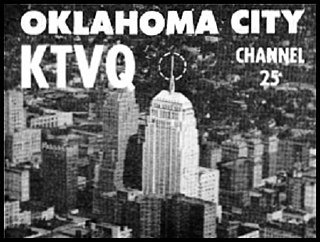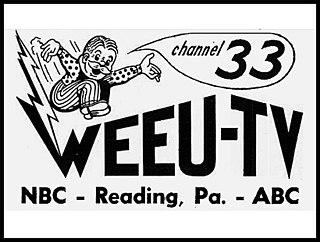Related Research Articles

KOAA-TV is a television station licensed to Pueblo, Colorado, United States, serving as the NBC affiliate for the Colorado Springs area. It is owned by E. W. Scripps Company alongside low-power Ion Mystery owned-and-operated station KZCS-LD. KOAA-TV's main studios and business offices are located on 7th Avenue in Pueblo, with a satellite studio and news bureau in the Tech Center office complex in Colorado Springs; its transmitter is located on Cheyenne Mountain.

KKTV is a television station in Colorado Springs, Colorado, United States, affiliated with CBS. The station is owned by Gray Television, and maintains studios on East Colorado Avenue in downtown Colorado Springs and a transmitter on Cheyenne Mountain.

KWGN-TV is a television station in Denver, Colorado, United States, serving as the local CW outlet. It is owned and operated by network majority owner Nexstar Media Group alongside Fox affiliate KDVR, channel 31. Both stations share studios on East Speer Boulevard in Denver's Speer neighborhood, while KWGN-TV's transmitter is located atop Lookout Mountain, near Golden.

KRDO-TV is a television station in Colorado Springs, Colorado, United States, affiliated with ABC. It is owned by the News-Press & Gazette Company (NPG) alongside low-power Telemundo affiliate KTLO-LD and radio stations KRDO and KRDO-FM (105.5). The four stations share studios on South 8th Street in Colorado Springs; KRDO-TV's transmitter is located on Cheyenne Mountain.
KCNC-TV, branded as CBS Colorado, is a television station in Denver, Colorado, United States, serving as the market's CBS outlet. It is owned and operated by the network's CBS News and Stations division, and maintains studios on Lincoln Street in downtown Denver; its transmitter is based on Lookout Mountain, near Golden.

WTVE was a television station in Elmira, New York, United States, which operated from 1953 to 1954 and again from 1956 to 1957. It was the first station to sign on in the Elmira area. It broadcast from studios on Market Street in Elmira and a transmitter on Comfort Hill, also known as South Mountain, near Ashland. Economic problems surrounding early UHF television stations played a major role in its demise and in its pursuit of a VHF channel assignment for Elmira, which was first granted and then taken away. It lost $350,000 in 44 months of broadcasting.

KTVQ, UHF analog channel 25, was an ABC-affiliated television station licensed to Oklahoma City, Oklahoma, United States, which operated from November 1, 1953, to December 15, 1955. The station was owned by the Republic Television and Radio Company. KTVQ's studios were located on Northwest 19th Street and North Classen Boulevard in northwest Oklahoma City's Mesta Park neighborhood, and its transmitter was located atop the First National Bank Building on North Robinson and Park Avenues in downtown Oklahoma City.
KCTY was a television station in Kansas City, Missouri, United States. It broadcast on ultra high frequency (UHF) channel 25 from June 6, 1953, to February 28, 1954, and was the second television station to begin broadcasting in the Kansas City area, after WDAF-TV. KCTY was an affiliate of the DuMont Television Network; and originally owned by the Empire Coil Company, which had pioneered UHF telecasting, DuMont purchased the station outright at the end of 1953 and operated it for two months as a study in the problems of struggling UHF stations nationwide before concluding that there was no path to economic viability. The studio for KCTY was located in the Pickwick Hotel in downtown Kansas City, Missouri; the transmitter was located in a rural area that today is part of Overland Park, Kansas.
XELD-TV was a television station located in Matamoros, Tamaulipas, Mexico, whose over-the-air signal also covered the Rio Grande Valley across the international border in the United States. The station broadcast in English and Spanish from September 15, 1951, to April 29, 1954.
KNUZ-TV was a television station broadcasting on ultra high frequency (UHF) channel 39 in Houston, Texas, United States, affiliated with the DuMont Television Network. It signed on the air on October 22, 1953, as Houston's third television station and first UHF outlet; it closed on June 25, 1954, after having lost money its entire existence and competing with two existing commercial very high frequency (VHF) outlets. KNUZ-TV's studios and transmitter were located at 4343 Cullen Boulevard in the Texas Television Center on the University of Houston campus.
KMPT, UHF analog channel 19, was a dual ABC/DuMont-affiliated television station licensed to Oklahoma City, Oklahoma, United States, which operated from November 22, 1953 to February 4, 1955. Owned by KLPR Television, Inc., it was a sister outlet to radio station KLPR. KMPT's studios were located on Southwest 28th and West Commerce Streets in southwest Oklahoma City's Capitol Hill neighborhood, and its transmitter was located on East Britton Road and North Lincoln Boulevard in northeast Oklahoma City.
WACH-TV, UHF analog channel 33, was a commercial television station licensed to Newport News, Virginia, United States, which broadcast from 1953 until 1955. The station was owned by the Eastern Broadcasting Corporation.

KTVE, UHF analog channel 32, was an independent television station licensed to Longview, Texas, United States that operated from 1953 to 1955. KTVE was one of the first television stations in east Texas. However, its use of the quickly outmoded UHF, and the arrival of a VHF station in the form of KLTV, made continued operation unviable, and the station closed on Christmas Day 1955.
KETX was a television station on channel 19 at Tyler, Texas, that operated between September 1953 and October 1954. It was the first television station in East Texas and the first UHF station in the entire state; however, its operation was fraught with technical and financial difficulties, and the coming of a VHF station, KLTV, was an existential threat to the smaller UHF outlet, causing its closure.

WEEU-TV was a television station that broadcast on UHF channel 33 from Reading, Pennsylvania, United States, between 1953 and 1955. It was owned by the Hawley Broadcasting Company alongside radio station WEEU. The station ceased broadcasting because of the economic difficulties associated with early UHF television stations.

WHUM-TV was a television station broadcasting on channel 61 in Reading, Pennsylvania, United States. Owned by Humboldt Greig alongside WHUM, the station—Reading's first—telecast from 1953 to 1956. It boasted the first ever high-powered UHF transmission facility, which spurred industry interest but also caused some technical issues; the station ultimately suffered from many of the same economic problems that befell other early UHF television outlets.
WRAY-TV was a television station broadcasting on channel 52 in Princeton, Indiana, United States. The station was owned and operated alongside radio station WRAY. It broadcast regular programming for just seven months, from December 1953 to July 1954, but broadcast one day a year through 1960 to carry a March of Dimes telethon.
WKAB-TV was a television station on channel 48 in Mobile, Alabama, United States. It was the first television station to broadcast in Mobile, operating from December 1952 to August 1954. As a UHF television station it was at a severe competitive disadvantage to the VHF station—WALA-TV—which started up in Mobile at the same time causing WKAB-TV to lose money and eventually fold.
KOPR-TV was a television station on channel 4 in Butte, Montana, United States, which operated from 1953 to 1954. It was owned by the Copper Broadcasting Company alongside KOPR and was the second outlet in Butte and the state, broadcasting from studios and a transmitter at the Hotel Finlen.

WLEV-TV was a television station in Bethlehem, Pennsylvania, United States. Owned by Associated Broadcasters Inc. alongside WEST, the station telecast from 1953 to 1957. It was the first station in the Lehigh Valley, which at one point had three local UHF outlets. However, the station ultimately suffered from many of the same economic problems that occurred at other early UHF television outlets, and largely due to competition from very high frequency (VHF) stations in Philadelphia, WLEV left the air at the end of October 1957.
References
- 1 2 3 4 5 "Colorado VHF Gives Up the Ghost" (PDF). Television Digest. May 15, 1954. p. 3 (33). Retrieved June 16, 2020.
- ↑ "More Post-Freeze Stations Being Sold" (PDF). Television Digest. August 1, 1953. p. 1. Retrieved June 16, 2020.
- ↑ "Telecasting Notes" (PDF). Television Digest. November 21, 1953. p. 12 (40). Retrieved June 16, 2020.
- ↑ "Banker Cage Game Opens TV Station". Casper Morning Star. United Press. December 5, 1953. p. 18. Retrieved June 16, 2020.
- ↑ "Channel Moves Asked" (PDF). Broadcasting. April 18, 1955. p. 9. Retrieved June 16, 2020.
- ↑ "For the Record" (PDF). Broadcasting. January 10, 1966. p. 85. Retrieved June 16, 2020.
- ↑ "For the Record" (PDF). Broadcasting. February 11, 1980. p. 128. Retrieved June 16, 2020.